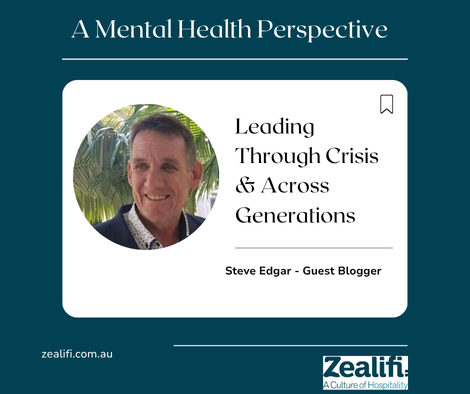Our guest blogger and great friend, Steve Edgar General Manager at Coolangatta Surf Club is focussed on mental health and would like to share his thoughts on ‘Leading through crisis and across generations: A Mental Health Perspective’.
Leadership isn’t just about making decisions—it’s about creating environments where people can thrive. Over the years, I’ve seen how strong leadership can bring teams together in the toughest times, and how poor leadership can drive good people away. Whether it’s navigating a crisis, managing generational shifts in the workplace, or building a culture where everyone feels safe and supported, the most important lesson I’ve learned is this: mental well-being and high performance go hand in hand.
Leading Through Crisis: Lessons from the Border Closures
Crisis reveals leadership at its core. When COVID-19 hit and the Queensland border closures took effect, Coolangatta Surf Club found itself in a situation that no one could have predicted. We lost half of our customer base overnight, our revenue plummeted, and uncertainty loomed over our 90-person team. My role as General Manager wasn’t just to keep the business afloat—it was to lead people through the storm.
- Communication Was Key
Silence in a crisis is deadly. I made it a priority to keep our team informed, even when there was no clear answer. People can handle tough news, but they can’t handle feeling left in the dark. - Empathy Before Strategy
Our staff weren’t just employees—they were individuals dealing with immense stress. Some had family members across the closed border, others were struggling financially. Leadership meant more than running a business—it meant checking in, listening, and ensuring they had support. - Adapting to Survive
We shifted our focus to the local community, streamlined operations, and did everything possible to retain staff. Flexibility became our greatest asset, and by embracing change rather than fearing it, we came out stronger.
Leading Across Generations: Why Leaders Must Adapt, Not Expect Gen Z To
One of the biggest challenges today is managing a multigenerational workforce. At Coolangatta Surf Club, I lead a team spanning Baby Boomers, Gen X, Millennials, and Gen Z. The mistake many leaders make is expecting younger employees to fit into the “old way” of doing things. That mindset is a fast track to losing good talent.
- Understanding Gen Z’s Mindset
Gen Z grew up in a world where mental health is openly discussed, where flexibility is expected, and where workplace culture matters as much as salary. They won’t tolerate toxic leadership or outdated hierarchies—and they shouldn’t have to. - Adapting Leadership Styles
This generation thrives on open communication, feedback, and purpose-driven work. If leaders don’t evolve to meet these expectations, they’ll struggle to retain younger employees. The good news? Adapting isn’t about lowering standards—it’s about changing how we engage and motivate people. - Balancing Performance & Well-Being
Gen Z is incredibly driven—but only in environments where they feel valued. High performance doesn’t come from pressure and micromanagement; it comes from psychological safety, clear expectations, and a culture that respects mental well-being.
Creating a Workplace Free from Bullying & Harassment
One of the most critical changes I implemented at Coolangatta Surf Club was creating an Employee Assistance Program (EAP) that prioritised mental well-being, zero tolerance for bullying, and a strong sense of belonging.
- Psychological Safety as a Priority
A high-performing team doesn’t just need physical safety—it needs emotional and psychological safety. This means employees must feel comfortable speaking up, reporting issues, and knowing they won’t be dismissed or punished for raising concerns. - Zero-Tolerance Culture
Many businesses say they have a zero-tolerance policy for bullying and harassment, but few actually enforce it. At Coolangatta Surf Club, we made it clear: bullying has no place in our organisation. Every employee was trained on workplace behaviour expectations, and we set up a confidential reporting system that ensured complaints were taken seriously and addressed swiftly. - Building a Culture of Belonging
A workplace isn’t just a place where people clock in and out—it’s a space where they spend a significant part of their lives. If people don’t feel like they belong, they won’t give their best. By actively fostering team connection, recognition, and support systems, we created an environment where people wanted to stay, grow, and contribute.
Leadership is About People, Not Just Business
If there’s one thing I’ve learned from leading through crisis and building strong teams, it’s this: your people are your greatest asset. No strategy, no system, no policy will ever replace the power of a motivated, engaged, and mentally healthy team.
If you want to explore these things a bit deeper, please make contact on 1300 122 287 or hello@zealifi.com.au, so you can find out how you can:
✅ Steer teams through crisis with clarity and compassion
✅ Adapt leadership styles to engage Gen Z without losing accountability
✅ Build workplace cultures where bullying, harassment, and toxicity don’t exist
Because in the end, great leadership isn’t just about business success—it’s about creating an environment where people want to bring their best selves to work every day.
Want to Discover More from Steve
Check out this video to discover more of Steve’s journey and how he has become a fundraising legend for Mental Health.
Reference from Mindful Conversations YouTube channel.

